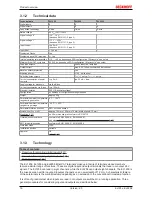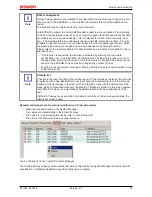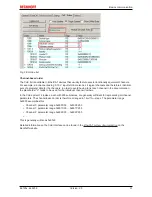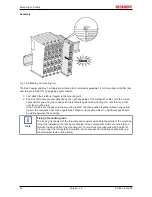
Product overview
EL125x, EL2258
20
Version: 2.5
• These functions require a process image that differs from the previous EL1252. For reasons of
compatibility with the existing user software the terminal can be switched to a compatible process
image (without the new functions).
• Sampling of the input state 0/1 takes place based on a microcycle of several µs, depending on the
selected setting, i.e. significantly faster than the EtherCAT bus cycle time
• The timestamp allocated to a signal edge detected in this way is the start time of the microcycle in
which it was picked up.
• An adjustable digital filter can be activated for each channel which blanks signals that are too short
(spikes).
• In this way significantly more signal changes can be sampled with timestamp during each cycle, and no
event information is lost in the buffer.
Fig. 18: Query of input channel information, with multi-timestamp
Outputs EL1259, EL2258
• 8 multi-timestamp channels on an overall width of 12 mm
• All channels operate completely independently of one another
• Each channel has a buffer and can therefore store not just one switching order, but up to 32 events.
Thus several precisely timed switching events can also be specified within a cycle.
• In order to transfer switching orders to the channel as quickly as possible, the multi-timestamp function
operates with AutoActivation: new switching orders are taken over in each cycle without special
activation; however, an optional handshake procedure is also possible here.
• The process data size – i.e. the number of time-stamped switching orders that can be sent by the
controller to the channel per cycle – is configurable for each channel.
• These functions require a process image that differs from the previous EL2252. For reasons of
compatibility with existing user software the terminal can be switched to a compatible process image
(without the new functions).
• The query whether an executable switching order is present in the buffer takes place based on a
microcycle of several µs, depending on the selected setting, and is therefore significantly faster than
the EtherCAT bus cycle time. Thus several timestamp switching orders are also possible per bus cycle.
• In order to test the actuator connected to the output channel, the output can also be switched manually
via the CoE, i.e. without timestamps.
• Thus virtually any desired number of switching orders can now be output per channel within the
framework of the microcycle, both ‘immediately’ for the following cycle (A) and also through the buffer
for later cycles (B).
















































